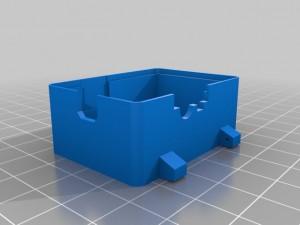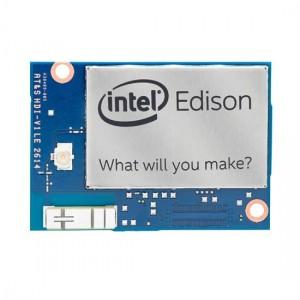 The idea for creating a 3D printed smartwatch case to house the miraculous and minuscule Intel® Edison emerged when Seattle, Washington-area tech expert Tyler Gibson attended a Hackathon and was musing over “a bunch of SparkFun Blocks” and one of the small but mighty Intel devices. Gibson decided he wanted to make a stand-alone, wearable device and engaged veteran software developer Jason Fox of Fort Worth, Texas to be his cross-country collaborator.
The idea for creating a 3D printed smartwatch case to house the miraculous and minuscule Intel® Edison emerged when Seattle, Washington-area tech expert Tyler Gibson attended a Hackathon and was musing over “a bunch of SparkFun Blocks” and one of the small but mighty Intel devices. Gibson decided he wanted to make a stand-alone, wearable device and engaged veteran software developer Jason Fox of Fort Worth, Texas to be his cross-country collaborator.
The Intel Edison is a tiny computer primarily intended for use as a development system for wearable devices. Despite its diminutive size, it contains a dual-core Intel Quark x86 CPU at 400 MHz, supports complex data collection, and communicates via Bluetooth and WiFi. The Edison was just the right size and had the kind of function Gibson wanted for his high-tech wrist computer.
In thinking about the case, Gibson decided not to start from scratch but, rather, to see if anyone else in the Thingiverse online community to which he belongs had already designed something he could adapt. Fortunately, a maker had indeed already done a good deal of Gibson’s work for him, at least where the design of the case and wrist strap for the device were concerned. He grabbed the .stl files and imported them into Rhinoceros 5 where he got to work transforming the pre-existing design to accommodate an Intel Edison.
His first 3D print was less than he’d hoped for. The smartwatch case looked good but, recalls Gibson, “the buttons didn’t work at all, the Dpad didn’t fit, the top cover printed with a single layer, the cutout in the back for wiring was too thin and didn’t print at all, the case was too tight, there was no way to get the LED in without cutting, and I forgot to put in holes for the charging port and on/off switch!” That spelled trouble for the maker–at least for this iteration.
Despite that fairly long list of shortcomings, Gibson wasn’t discouraged. He decided that, rather than “throwing the files up on the web as-is,” he’d basically start over, using the failure to inform the additional adjustments he needed to make. He felt like he’d be letting down people who might want to 3D print the smartwatch case for themselves but either did not have expensive modeling software or didn’t own 3D printers that print as well as his.
It was back to the drawing board, including measuring everything again. Gibson recalled:
“Even though I used calipers to measure everything multiple times, I still got almost every dimension wrong! There is a big difference between what you measure, model and print. FDM (Fused Deposition Modeling) printers need quite a bit of tolerance to account for differences in materials, temperatures, hotends, and software slicers.”
 In the end, Gibson persevered, making changes directly to the 3D model of the smartwatch case and designing it so that all parts would snap together and thus no gluing would be required. In that regard, he had some sage advice: “Snap-fit parts,” recommended Gibson, “need 0.2mm – 0.3mm of tolerance, or about ½ the width of your tip.” He maintains that, while most people are pretty reticent about designing snap-fit parts, they are worth the effort when objects assemble so easily.
In the end, Gibson persevered, making changes directly to the 3D model of the smartwatch case and designing it so that all parts would snap together and thus no gluing would be required. In that regard, he had some sage advice: “Snap-fit parts,” recommended Gibson, “need 0.2mm – 0.3mm of tolerance, or about ½ the width of your tip.” He maintains that, while most people are pretty reticent about designing snap-fit parts, they are worth the effort when objects assemble so easily.
Another excellent bit of advice Gibson offered was to avoid making your models overly complicated and carefully measure before getting too far into the modeling process. In fact, his process involves four steps: measure, model, print, and repeat. In other words, check your work as you go.
If you want to take on this project, you actually don’t need to start from the drawing board as Gibson has shared his files on Thingiverse and you can read his process blog, where he’s shared lessons learned along the way. He has yet to post the code, circuit schematics and internal details for the smartwatch case but insists they’re coming soon to Thingiverse.
Subscribe to Our Email Newsletter
Stay up-to-date on all the latest news from the 3D printing industry and receive information and offers from third party vendors.
You May Also Like
3D Printing Unpeeled: New Arkema Material for HP, Saddle and Macro MEMS
A new Arkema material for MJF is said to reduce costs per part by up to 25% and have an 85% reusability ratio. HP 3D HR PA 12 S has been...
3D Printing News Briefs, January 20, 2024: FDM, LPBF, Underwater 3D Printer, Racing, & More
We’re starting off with a process certification in today’s 3D Printing News Briefs, and then moving on to research about solute trapping, laser powder bed fusion, and then moving on...
3D Printing Webinar and Event Roundup: December 3, 2023
We’ve got plenty of events and webinars coming up for you this week! Quickparts is having a Manufacturing Roadshow, America Makes is holding a Member Town Hall, Stratafest makes two...
Formnext 2023 Day Three: Slam Dunk
I’m high—high on trade show. I’ve met numerous new faces and reconnected with old friends, creating an absolutely wonderful atmosphere. The excitement is palpable over several emerging developments. The high...
































